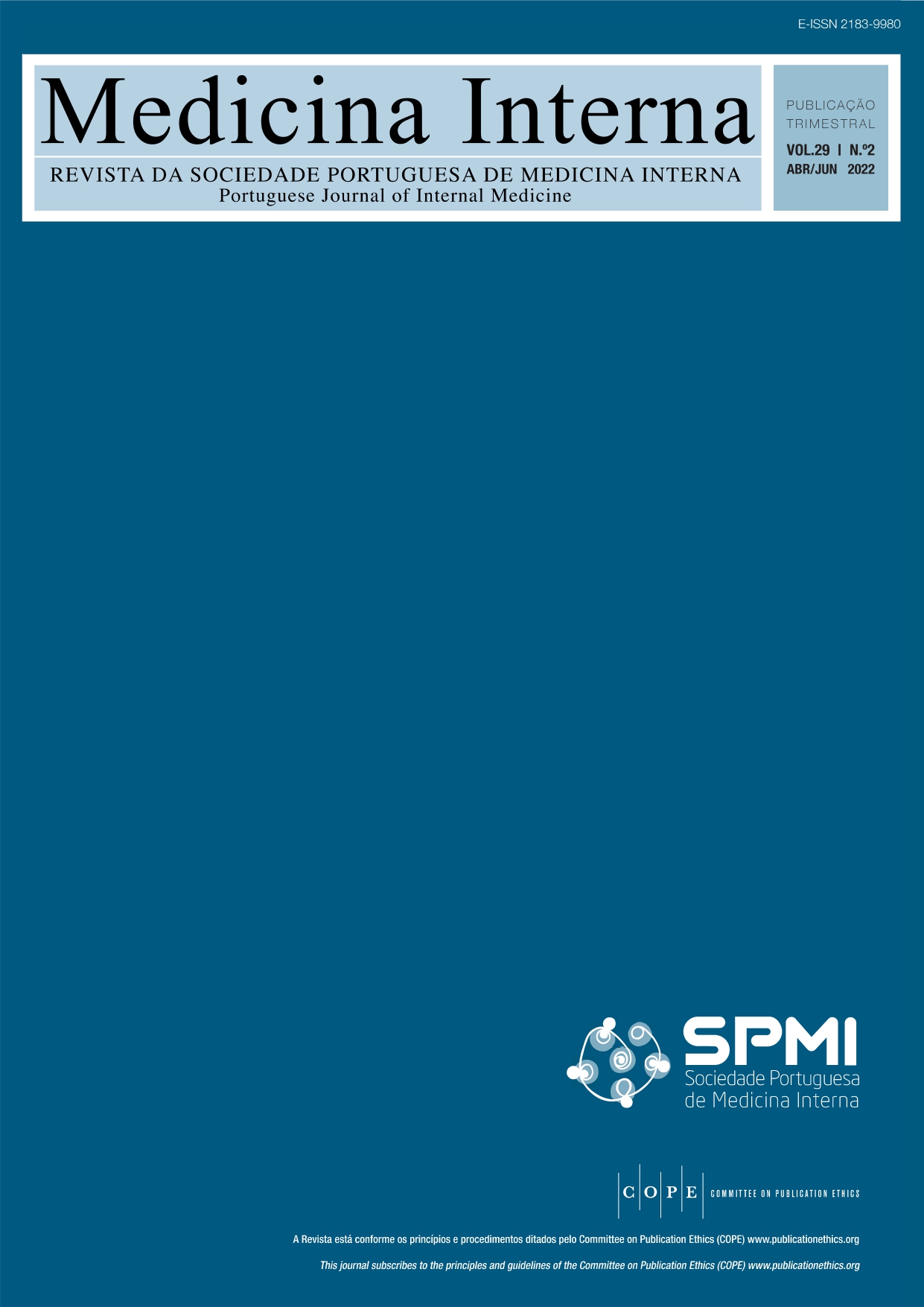Síndrome de Libertação de Citocinas em Doentes sob Tratamento Oncológico com CAR-T
DOI:
https://doi.org/10.24950/rspmi.287Palavras-chave:
Receptores de Antígenos de Linfócitos T, Receptores de Antígenos Quimérico, Síndrome de Libertação de Citocinas/tratamento farmacológicoResumo
Dado o desenvolvimento e crescente utilização da imunoterapia como opção terapêutica na doença oncológica, nomeadamente através de células T recetoras de antigénio quimérico (CAR-T), torna-se essencial uma expansão do conhecimento da gestão das toxicidades associadas. A síndrome de libertação de citocinas (SLC) e a neurotoxicidade associada a terapêuticas com CAR-T são as duas condições mais frequentes e são não só potencialmente fatais, mas também de difícil diagnóstico, uma vez que mimetizam outras patologias, como a sépsis. Com esta revisão bibliográfica, pretendemos caracterizar a SLC em doentes oncológicos sob terapêutica com CAR-T, com um enfoque particular na clínica e gestão terapêutica desta síndrome.
Downloads
Referências
Shimabukuro-Vornhagen A, Gödel P, Subklewe M, Stemmler HJ, Schlößer HA, Schlaak M, et al. Cytokine release syndrome. J Immunother Cancer. 2018;6:56. doi: 10.1186/s40425-018-0343-9.
Murthy H, Iqbal M, Chavez JC, Kharfan-Dabaja MA. Cytokine Release Syndrome: Current Perspectives. ImmunoTargets Ther. 2019; 8:43–52.
Cosenza M, Sacchi S, Pozzi S. Cytokine release syndrome associated with T-cell-based therapies for hematological malignancies: Pathophysiology, clinical presentation, and treatment. Int J Mol Sci. 2021;22:7652. doi: 10.3390/ijms22147652. .
Kennedy LB, Salama AKS. A review of cancer immunotherapy toxicity. CA Cancer J Clin. ; 2020;70:86–104.
Liu D, Zhao J. Cytokine release syndrome: grading, modeling, and new therapy. J Hematol Oncol. 2018;11:121. doi: 10.1186/s13045-018-0653-x.
Lee DW, Santomasso BD, Locke FL, Ghobadi A, Turtle CJ, Brudno JN, et al. ASTCT Consensus Grading for Cytokine Release Syndrome and Neurologic Toxicity Associated with Immune Effector Cells. Biol Blood Marrow Transplant. 2019;25:625-38. doi: 10.1016/j.bbmt.2018.12.758.
Frey N, Porter D. Cytokine Release Syndrome with Chimeric Antigen Receptor T Cell Therapy. Biol Blood Marrow Transplant. 2019;25:e123-e127. doi: 10.1016/j.bbmt.2018.12.756. E
Lee DW, Kochenderfer JN, Stetler-Stevenson M, Cui YK, Delbrook C, Feldman SA, et al. T cells expressing CD19 chimeric antigen receptors for acute lymphoblastic leukaemia in children and young adults: A phase 1 dose-escalation trial. Lancet. Lancet . 2015;385:517–28.
Brudno JN, Kochenderfer JN. Recent advances in CAR T-cell toxicity: Mechanisms, manifestations and management. Blood Rev. 2019;34:45-55. doi: 10.1016/j.blre.2018.11.002.
Shin YH, Tian X, Park JJ, Kim GY, Aboujaoude E, Sturgill MG. Management of chimeric antigen receptor T-cell induced cytokine release syndrome: Current and emerging approaches. J Oncol Pharm Pract. 2022;28:159-74. doi: 10.1177/10781552211039238.
Yescarta | European Medicines Agency [Internet]. [consultado a 9 Dez 2021]. Disponivel em: https://www.ema.europa.eu/en/medicines/human/EPAR/yescarta
Kymriah | European Medicines Agency [Internet]. [consultado a 9 Dez 2021]. Disponivel em: https://www.ema.europa.eu/en/medicines/human/EPAR/kymriah
Brudno JN, Kochenderfer JN. Toxicities of chimeric antigen receptor T cells: Recognition and management. Blood. 2016;127:3321-30. doi: 10.1182/blood-2016-04-703751.
Bahadur G, Ozturk O, Muneer A, Wafa R, Ashraf A, Jaman N, et al. Semen quality before and after gonadotoxic treatment. Hum Reprod. 2005;20:774–81.
Fajgenbaum DC, June CH. Cytokine Storm. N Engl J Med. 2020;383:2255-73. doi: 10.1056/NEJMra2026131.
Morris EC, Neelapu SS, Giavridis T, Sadelain M. Cytokine release syndrome and associated neurotoxicity in cancer immunotherapy. Nat Rev Immunol. 2022;22:85–96.
Common Terminology Criteria for Adverse Events (CTCAE) [Internet]. National Cancer Institute - Division of Cancer Treatment & Diagnosis. [consultado a 10 Dez 2021]. Disponivel em: https://ctep.cancer.gov/protocoldevelopment/electronic_applications/ctc.htm
Park JH, Rivière I, Gonen M, Wang X, Sénéchal B, Curran KJ, et al. Long-Term Follow-up of CD19 CAR Therapy in Acute Lymphoblastic Leukemia. N Engl J Med. 2018;378:449–59.doi:10.1056/NEJMoa1709919
Neelapu SS, Tummala S, Kebriaei P, Wierda W, Gutierrez C, Locke FL, et al. Chimeric antigen receptor T-cell therapy-assessment and management of toxicities. Nat Rev Clin Oncol. 2018;15:47-62. doi: 10.1038/nrclinonc.2017.148.
Belay Y, Yirdaw K, Enawgaw B. Tumor Lysis Syndrome in Patients with Hematological Malignancies. J Oncol. 2017;2017:9684909. doi:
1155/2017/9684909.
Messmer AS, Que YA, Schankin C, Banz Y, Bacher U, Novak U, et al. CAR T-cell therapy and critical care: A survival guide for medical emergency teams. Wien Klin Wochenschr. 2021;133:1318–25. doi: 10.1007/s00508-021-01948-2.
Singer M, Deutschman CS, Seymour C, Shankar-Hari M, Annane D, Bauer M, et al. The third international consensus definitions for sepsis and septic shock (sepsis-3). JAMA. 2016;315:801-10. doi: 10.1001/jama.2016.0287.
Hill JA, Li D, Hay KA, Green ML, Cherian S, Chen X, et al. Infectious complications of CD19-targeted chimeric antigen receptor modified T-cell immunotherapy. 2018. Disponível em: http://ashpublications.org/blood/article pdf/131/1/121/1367372/blood793760.pdf
Maude SL, Barrett D, Teachey DT, Grupp SA. Managing cytokine release syndrome associated with novel T cell-engaging therapies. Cancer J. 2014;20:119-22. doi: 10.1097/PPO.0000000000000035
Franceschini F, Bottau P, Caimmi S, Cardinale F, Crisafulli G, Liotti L, et al. Mechanisms of hypersensitivity reactions induced by drugs. Acta Biomed. 1885; 2019: 44–51.
Riegler LL, Jones GP, Lee DW. Current approaches in the grading and management of cytokine release syndrome after chimeric antigen receptor T-cell therapy. Ther Clin Risk Manag. 2019;15:323-35. doi: 10.2147/TCRM.S150524.
Xiao X, Huang S, Chen S, Wang Y, Sun Q, Xu X, et al. Mechanisms of cytokine release syndrome and neurotoxicity of CAR T-cell therapy and associated prevention and management strategies. J Exp Clin Cancer Res. 2021;40:367. doi:10.1186/s13046-021-02148-6
RoActemra | European Medicines Agency [Internet]. [consultado a 10 Dez 2021]. Available from: https://www.ema.europa.eu/en/medicines/human/EPAR/roactemra
Kotch C, Barrett D, Teachey DT. Tocilizumab for the treatment of chimeric antigen receptor T cell-induced cytokine release syndrome. Expert Rev Clin Immunol. 2019;15:813-22. doi: 10.1080/1744666X.2019.1629904.
Sylvant | European Medicines Agency [Internet]. [consultado a 10 Dez 2021]. Disponível em: https://www.ema.europa.eu/en/medicines/human/EPAR/sylvant
Rossignoli F, Grisendi G, Spano C, Golinelli G, Recchia A, Rovesti G, et al. Inducible Caspase9-mediated suicide gene for MSC-based cancer gene therapy. Cancer Gene Ther.; 2019;26:11–6. doi: 10.1038/s41417-018-0034-1.
Kineret | European Medicines Agency. [consultado a 10 Dez 2021]. Disponivel em: https://www.ema.europa.eu/en/medicines/human/EPAR/kineret
Yu S, Yi M, Qin S, Wu K. Next generation chimeric antigen receptor T cells: Safety strategies to overcome toxicity. Mol Cancer. 2019;18:125. doi: 10.1186/s12943-019-1057-4.
Downloads
Publicado
Como Citar
Edição
Secção
Categorias
Licença
Direitos de Autor (c) 2022 Medicina Interna

Este trabalho encontra-se publicado com a Licença Internacional Creative Commons Atribuição 4.0.
Direitos de Autor (c) 2023 Medicina Interna
Acesso livre










